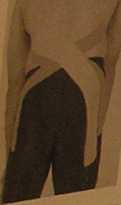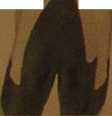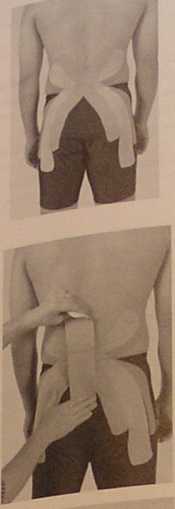P5140045


Measure a strip of 3" wide Kinesio Tape appro\j. mately the same length as used in the first Jayer. Begin byplacing the base slightly medialiy and interior to the first strip.
Have the patient move into as much hip flexiona« is allowcd. Angle the strip over the iscial tuberosify and over the area of pa in applying 25-50 % ofavajj. able tension.
With the patient in hip flexion have them also moveinto lateral bending to the opposite side. Lay down the remaining length of Kinesio Tape.
Initiate glue acfivation prior to any further patient movement.


For the opposite side, repeat the above steps.

W A f

Measure a strip of 2" wide Kinesio Tape approsd-mately the same length as used in the first layer. Begin by placing the base slightly medialiy and superior to the second strip.
Have the patient move into as much hip flexion as is allowed. Angle the strip over the iscial tuberosity and over the area of pain applying 25-50 % ofavail-able tension.
Initiate glue activation prior to any further patient m ovement


Application of a space correction using a Kinesio I strip. For complete reyiew see space correction application techniąue modified 1 strip.
Begin the base of a 2 or 3" (depending upon patient size) Kinesio I strip 10-12 inches in length in the coccyx region with no tension.
Have the patient move into as much hip flexion as possible. Apply 25-50 % of available tension to the Kinesio I strip over the area of pain. Lay down the last 2-3 inches with no tension.
This strip may be modified by applying the 25-50 % available tension to the center of the Kinesio I strip with application directly over the area of pain.
Initiate glue activation prior to any further patient movement.
The finał strip is applied by repeating the above step.
The practitioner may determine that one, two, three or all four strips are appropriate. Size, activity, patient strength level, and clinical condition along with practitioner experience will determine the appropriate taping application.
47
Wyszukiwarka
Podobne podstrony:
P5140031 Completed example of possible Kinesio Taping Technique for shoulder instability -
Data Expiry There are two types of data expiry within a memcached instance. The first type is applie
63 SOME MORĘ RESTORATIONS OF PRAKRIT YERSES.... difliculty is ihat the first half of ihe versc rcmai
314 Aneta Krzewińska, Ilona Przybytowska writing of semester, BA and MA papers. The first part prese
15c 2 Ko i nesVii.se of Flowers FI owe r Kit Thevc paltem dcuiU
P5140036 ą^iraHon oLKines^ V ,, . of mtemal rotattoS1 by ^oftbe Kinesio Y strip on thc post^C1 ^rofh
P5140047 ~ Anplic^ion of psoas major basie Option , strip- Kinesio Taping &nb
P5140037 1 1 .A/hen appr°ximafe,y 1/2 of *e Kinesi^ „ been applied s,lde 1% hand whi.ch ty, sfci W%$
P5140077 Quadriceps Strain/Conntusion Combination Technique " "*•<! Combination of thc
P5140080 Hamstring Strain Combination Technique Combination of thc Kinesio Taping Technique and use
P5140090 Patella Tendonitis Combination Taping/Bracing The practitioner may desire to use a combinat
P5140123 SBsu. Usinz a 1 inch athleHc tape begin one strip on the base of the plantar surface of the
Wheel Master WM-2 Easier to use and morę accurate than ever Measures diameters of both wheels and ca
304 Karolina Górnik The rangę of private banking services is wide and typically consistent with the
image058 *i. Entry of Brookfield Measurements Number of Brookfield rpm-viscosity pairs in Bob You ca
* 1 9 * i 9 *- h # »Only one tape deck combines the incredible realism of dbx with the precisesound
Creative Doughcraft 3 t PARACHUTE MAN Make a smali scarf from a strip of thinly rolled out dough. Pu
więcej podobnych podstron